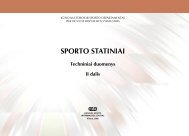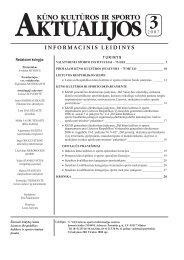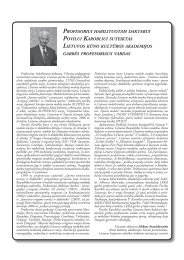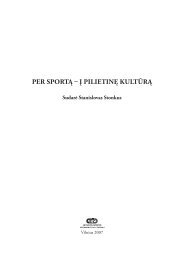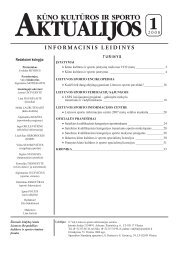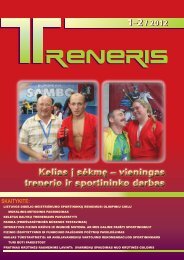Nr. 3 - Lietuvos sporto informacijos centras
Nr. 3 - Lietuvos sporto informacijos centras
Nr. 3 - Lietuvos sporto informacijos centras
Create successful ePaper yourself
Turn your PDF publications into a flip-book with our unique Google optimized e-Paper software.
78<br />
SPORTO MOKSLAS<br />
THE PECULIARITIES OF TRAINING OF SHORT DISTANCE RUNNERS AT DIFFERENT TIMES<br />
Prof. Dr. Habil. Aleksas Stanislovaitis, Assoc. Prof. Dr. Jūratė Stanislovaitienė, Rytis Sakalauskas<br />
Lithuanian Academy of Physical Education<br />
Up to 1960, there was considered that one must<br />
be born to be short distance runner, and only after<br />
the victories of Arminn Hary and Valeriy Borzov at<br />
Olympic Games in 1960 and in 1972, it became clear<br />
that short distance running features characteristic<br />
only for black athletes, could also be developed<br />
using special preparation (Doherty, 2007). Basing<br />
on the analysis of the modern competitive activities,<br />
we will attempt to answer the question what are the<br />
trends in short distance runners training.. The aim of<br />
the research was to examine short distance runners<br />
training features in different time periods. Subjects:<br />
the study included short distance runners: n = 12 (years<br />
2000–2009, height 1,84 ± 0,12 m; weight 81,25 ± 3,73<br />
kg); n = 16 (years 1990 – 1999, height 1,80 ± 0,10 m;<br />
weight 83,73 ± 4,04 kg). The data on the world’s best<br />
Aleksas Stanislovaitis<br />
<strong>Lietuvos</strong> kūno kultūros akademijos Treniravimo mokslo katedra<br />
Sporto 6, LT–44221 Kaunas<br />
El. paštas: a.stanislovaitis@lkka.lt<br />
summary<br />
short-distance runners 100 m results were taken from<br />
the magazine “Атлетика” (2007) (Bulgaria) and from<br />
www.iaaf.com. Results. We found that between 1990<br />
and 1999 sprinters had speed advantage in the first 10<br />
m, while from 2000 to 2009 sprinters had the advantage<br />
of following distances, and the running speed at 60, 70,<br />
80 m was statistically significant. Today’s world’s elite<br />
sprinters in 100 m distance achieve higher maximum<br />
speed performance. From 40 to 60 m, the maximum<br />
running speed aver age is 11.69 m/s. Some athletes<br />
reach over 12 m/s.: Usain Bolt 12.34 m/s, Tyson Gay,<br />
12.20 m/s. Usain Bolt loses the first 10m to the best<br />
sprinters in the world, but from 20 m to 100 m he<br />
shows higher speed increment. In 20 meters Usain<br />
Bolt outstrips his rivals 0.03 seconds, while in the<br />
100 m, this difference increases to 0.28 s.<br />
Keywords: sprinting, training.<br />
Gauta 2012 08 28<br />
Patvirtinta 2012 09 28



